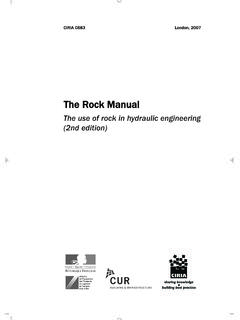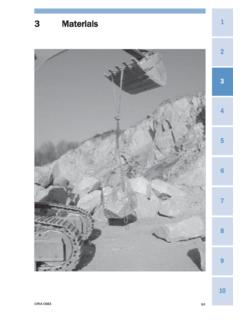Transcription of The rock manual - Chapter 1 - VKC-Water
1 1 Introduction 1. 2. 3. 4. 5. 6. 7. 8. 9. 10. CIRIA C683 1. 1 Introduction Chapter 1 CONTENTS. Use of rock .. 3. Background to the manual .. 4. Structure of the manual .. 4. Chapters.. 4. Use of the manual .. 5. Target readership and experience .. 7. Scope .. 8. Changes from earlier manuals .. 8. Structure types considered .. 9. Marine structures .. 10. Closure works .. 12. River and canal structures .. 13. References .. 14. 2 CIRIA C683. Use of rock 1 Introduction 1. This flow chart shows the links between the technical chapters that follow this introductory Chapter . It is repeated at the start of each Chapter and expanded to show more detail of the 2. contents of the relevant Chapter . Use it in conjunction with the contents page and the index to navigate the manual . 2 Planning and designing rock works 3. 5 Physical processes and 4 Physical site conditions and 3 Materials design tools data collection 4.
2 6 Design of marine structures 7 Design of closure works 8 Design of river and canal structures 5. 9 Construction 6. 10 Monitoring, inspection, maintenance and repair USE OF ROCK. 7. Rock is a commonly used construction material in the hydraulic environment. It is used in the marine and fluvial environments to provide protection against scour and erosion and to limit wave overtopping and flooding. 8. Rock is quarried to produce armourstone, defined as coarse aggregate used in hydraulic structures and other civil engineering works. This may be produced in masses ranging from approximately 1 kg up to 20 30 tonnes. Rock may be employed as an armouring material, as a filter or underlayer, or as a fill material. Where armourstone of sufficient size or quality is not available then artificial units (generally of concrete) may be used.
3 Gabion boxes or mattresses filled with smaller armourstone are another alternative. Other materials, such as industrial by-products, may also be used instead 9. of quarried rock. Standard solutions do not generally exist in this field of engineering. To develop a robust, site-specific rock-based solution for a project it is necessary to consider a wide range of issues including materials, environmental conditions, construction methodology, maintenance regime and health and safety for construction personnel and the general public. 10. CIRIA C683 3. 1 Introduction BACKGROUND TO THE manual . In 1991 CIRIA/CUR published the original manual on the use of rock in coastal and shoreline engineering, commonly referred to as The Rock manual . This was followed in 1995 by the manual on the use of rock in hydraulic engineering by CUR. Two French reference books were produced during the late 1980s: Le dimensionnement des digues talus (EDF-LNH, 1987) and Les Enrochements (LCPC, 1989).
4 Since these books were published there have been many advances in the understanding of rock as a material and of the design and behaviour of rock structures in the hydraulic environment. This new edition of The Rock manual presents current good practice for the design and construction of rock structures. Where appropriate, it presents new or emerging technologies that have not, at the time of writing, become standard practice, to allow the reader to be fully aware of, and make best use of, the latest research findings. Section defines the scope of this updated manual and includes a list of changes from the earlier versions. The manual has been updated by a principally British, Dutch and French team and has benefited from extensive international review to ensure that it provides guidance on current good practice worldwide. The manual collates available research data and technical information together with practical experience gained by practitioners.
5 In doing this, care has been taken to indicate current limitations in the design processes and the extent to which empirical methods and engineering judgement are involved. A full list of acknowledgements to the organisations and individuals who have contributed to the updating of The Rock manual is provided at the beginning of this manual . STRUCTURE OF THE manual . Chapters 1 Introduction explains the philosophy behind the manual , the key features of the update and the structure of the contents. 2 Planning and designing rock works discusses key considerations for a rock project in the hydraulic environment. This Chapter is an important first point of reference in the manual , as it provides an aide memoire of issues that should be addressed. Readers are encouraged to read this Chapter before proceeding with other chapters. The contents have been kept concise and focused to aid usability.
6 3 Materials discusses the range of issues with regard to armourstone and other material selection, including concrete armour units. The Chapter considers source evaluation, properties, performance prediction, quarry yields and quarry operations. It describes the various testing methods to determine rock and armourstone properties. It cross- references to the European armourstone specification EN 13383. 4 Physical site conditions and data collection describes how to derive hydraulic, geotechnical and ice conditions and summarises data collection. Designers can use this Chapter as the starting point for design, but it is also relevant to contractors and suppliers who need information on environmental conditions for construction operations. 5 Physical processes and design tools presents design methods for rock structures in both marine and fluvial environments.
7 It covers hydraulic performance, structural stability and geotechnical behaviour. The hydraulic and geotechnical parameters derived in Chapter 4 and the material characteristics derived from Chapter 3 are the key inputs to this Chapter . 4 CIRIA C683. Structure of the manual 6 Design of marine structures. See below. 1. 7 Design of closure works. See below. 8 Design of river and canal structures. See below. Chapters 6, 7 and 8 provide practical guidance for the design of different types of 2. structure. These chapters take the outputs from the design methods in Chapter 5 and provide guidance for the geometry (plan layout, cross-section) and structure details taking into account the constraints that exist, such as buildability and access (discussed in Chapter 9), availability of resources (discussed in Chapter 3) and maintenance (discussed in Chapter 10).
8 In particular, Chapters 6 8 cover plan layout, geometry of cross-sections, structural details (toe, crest etc), transitions and joints, design-related construction, cost 3. and maintenance considerations, and repair and upgrading of existing structures. Selection of appropriate design conditions is also covered in these chapters. 9 Construction covers commonly used equipment and transport, site and location considerations (including site preparation), quality control in rock structures (including placing and packing, survey and measurement techniques), health and safety, and risks. 4. Some methods of construction are described for the most common hydraulic structures using rock. 10 Monitoring, inspection, maintenance and repair discusses monitoring techniques, appraisal of structure performance, and repair and construction methods.
9 5. Use of the manual The following features are designed to assist readers in navigating the manual : Diagram of general structure. Figure provides a flow chart of the structure and con- tents of the complete manual . It also suggests a relationship between the advice given and key phases of a typical project. 6. Diagram of content relevance to different users. Table presents an evaluation of the content from different users' perspectives to assist the reader in finding information relevant to his or her needs. High-level contents list. This is given for the complete manual at the start of the book. Detailed contents list. At the start of each Chapter there is a contents list for that 7. Chapter only. Structure of each Chapter . The front end of each Chapter includes: a detailed contents list for that Chapter an introductory box that describes what is included in the Chapter 8.
10 A flow chart to demonstrate how the Chapter links with other chapters. Where am I? Each page tells the reader their current location in the manual . The Chapter number is shown on the navigation bar running down the outer edge of right-hand pages, the Chapter number and title are given on the left hand page header, while the section number and title are given on the right hand page header. Index of key topics. The index lists key topics by section number. A complete index of words is not included as most subjects should be easily locatable through the high-level contents list at the front of the book and the detailed Chapter contents pages. The index 9. is particularly useful for locating discussion of topics that span several chapters. Electronic version. The complete manual is available on the CD-Rom attached to the inside back cover of the book and on the web at the CIRIA and CETMEF websites < > < >.








